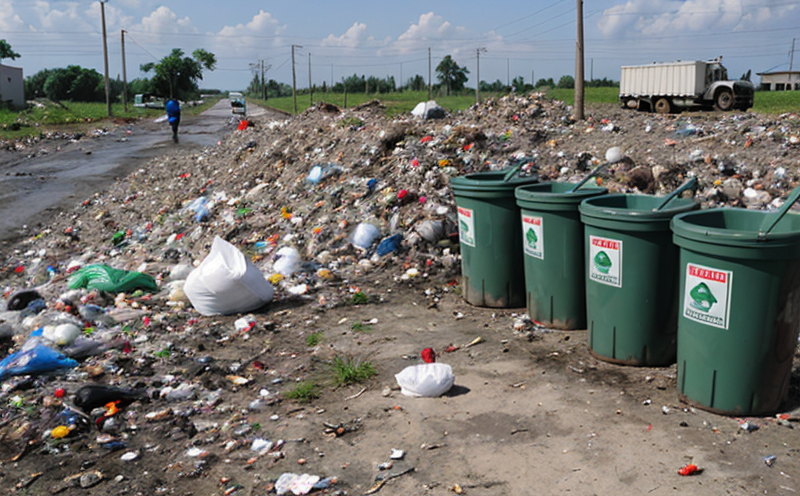EN 12457-4 Leaching Behaviour of Solid Waste Test
The EN 12457-4 standard is a crucial tool in assessing the leaching behaviour of solid waste materials. This test evaluates how hazardous substances, such as heavy metals and other pollutants, may be released into the environment during the storage or disposal of solid waste. The standard ensures that waste management practices are environmentally responsible by preventing contamination of soil, water bodies, and groundwater.
The procedure involves placing a specified amount of solid waste in a leaching solution under controlled conditions for a set duration. This allows for the quantification of dissolved substances released from the waste into the solution. The test results provide valuable data that can inform decisions regarding the suitability of waste disposal methods or the need for additional treatment processes.
The primary goal of this testing is to ensure compliance with environmental regulations and to protect public health. By understanding which materials are likely to leach, facilities can implement strategies to minimize environmental impact. This includes selecting appropriate liners and leachate collection systems, as well as designing waste disposal facilities that enhance containment.
For quality managers and R&D engineers involved in solid waste management, the EN 12457-4 test offers critical insights into potential risks associated with different types of waste. Compliance officers can use these results to ensure regulatory compliance and demonstrate due diligence. In procurement processes, understanding leaching behaviour helps in selecting suppliers who adhere to stringent environmental standards.
The testing process typically involves several steps:
- Sampling the solid waste to be tested
- Determining the appropriate leaching solution based on the type of waste
- Placing the sample in a controlled environment for a specified time period
- Measuring and analyzing the concentration of dissolved substances in the leachate
- Interpreting results against predefined acceptance criteria
The interpretation of these results is crucial as it directly influences decisions related to waste management practices. For instance, if high levels of heavy metals are detected, additional treatment steps may be necessary before disposal.
It's essential for those conducting this test to have a thorough understanding of the EN 12457-4 standard to ensure accurate and reliable results. This knowledge is particularly important when dealing with complex mixtures of waste materials, where multiple contaminants could be present.
The test's significance extends beyond compliance; it plays a vital role in sustainable waste management by promoting the development of safer, more environmentally friendly practices. Understanding the leaching behaviour allows for informed decisions that balance economic considerations with environmental responsibility.
Why It Matters
The importance of this test cannot be overstated, especially given the increasing global focus on sustainable waste management and the reduction of environmental pollution. By identifying hazardous substances that may leach from solid waste, facilities can take proactive measures to mitigate risks. This includes implementing best practices for waste storage and disposal, which ultimately contributes to a cleaner environment.
The results of this test are also critical for regulatory compliance. Many countries have stringent regulations governing the release of pollutants into the environment, and failure to meet these standards can lead to significant legal and financial consequences. Ensuring that testing is conducted according to EN 12457-4 guidelines helps facilities stay ahead of potential issues.
The broader impact of this test extends beyond individual facilities; it contributes to global efforts to reduce pollution and protect ecosystems. By preventing the release of harmful substances into soil, water bodies, and groundwater, waste management practices become more sustainable. This supports long-term environmental health and safety goals.
For quality managers and R&D engineers, understanding this test is essential for optimizing waste management processes. It allows them to identify potential risks early on and implement preventive measures. In procurement, selecting suppliers who adhere to such rigorous testing ensures that the entire supply chain maintains high standards of environmental responsibility.
International Acceptance and Recognition
The EN 12457-4 standard is widely recognized across Europe and beyond, with many countries adopting it as a basis for their own regulations. Its international acceptance ensures that test results are consistent and comparable worldwide.
Australia: The Australian Standard AS/NZS 3891:2014 aligns closely with EN 12457-4, ensuring compatibility in test procedures and results.
United States: While the U.S. does not have an identical standard, similar tests are conducted following EN guidelines to ensure consistency with global practices.
India: The Indian Standard IS 15739:2006 incorporates aspects of EN 12457-4, reflecting the growing international consensus on waste management standards.
The widespread adoption of this standard underscores its importance in promoting global environmental stewardship. Compliance with EN 12457-4 not only ensures local regulatory compliance but also facilitates trade by ensuring that products meet international standards.
Environmental and Sustainability Contributions
The implementation of the EN 12457-4 standard contributes significantly to environmental sustainability efforts. By reducing the release of hazardous substances into the environment, facilities can play a key role in protecting ecosystems and public health. This aligns with broader sustainability goals aimed at reducing pollution and promoting resource efficiency.
Reduction in Soil Contamination: The test helps identify pollutants that could potentially contaminate soil during waste disposal, prompting the use of protective measures to prevent this from happening.
Water Quality Protection: Ensuring that leaching does not contribute to water pollution is crucial for maintaining clean water sources and supporting aquatic ecosystems. This aligns with global initiatives aimed at improving water quality worldwide.
Economic Benefits: By adopting sustainable waste management practices, facilities can reduce operational costs associated with environmental remediation projects. This makes resources available for more productive uses within the organization.
The test also supports broader sustainability goals by promoting transparency and accountability in waste management processes. Stakeholders can rely on consistent and reliable data to make informed decisions that align with long-term environmental objectives.
Ultimately, the EN 12457-4 standard is a cornerstone of sustainable waste management practices, contributing to both immediate compliance needs and long-term environmental health goals.





